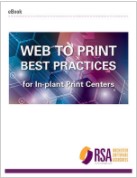- Vince Tutino
- |
- November 08, 2016

Best Practices for Web to Print Production and Automation
Web to print systems come in a couple of different types to drive print production and workflow automation:
- Web Ordering– Download and Print (offers only submission)- This type offers an e-commerce front-end to submit jobs to the print center but does not send print jobs directly to printers. Print jobs are still manually sent to the printers by production print staff. These are generally good for low volume operations and will have a lower overall cost. This type of system can be a good way to get started with Web to print. For some shops, this may be all that you need. On the negative side, if your operation is growing and volumes start to rise, or you are already short staffed, you may run out of options if there is no upgrade path to a more full-featured system that supports automated workflows and direct to printer submission with job ticketing. Sometimes these systems will integrate with another software package for the printing, or they may print only to one vendor's printers.
- Web Ordering– Production Ticketing and Automation Capabilities- There are Web to print systems like WebCRD that can scale from an ordering front-end to a full production workflow system for processing jobs, releasing jobs directly to production printers and utilizing automation rules to further reduce touches and decrease turnaround times. We have seen customers double and triple their print volume and not need to add staff due to the workflow efficiencies. In this type of system, you can generally add other tools and integrations to other software packages like Print MIS systems or print specific workflow tools such as make ready, variable data print (VDP) and output management.
4 Web to Print Production and Automation Best Practices
- Wait to Establish Automation. As you get started with Web to print, ease into automations as you collect data on system use. Set up automations once you fully understand and are comfortable with the order and job processing workflows. Get used to things first, tune the system so that it is all working properly and then look for opportunities to automate.
- Start with the simple things and add more as you go. Don't feel that you need to do everything at once. Analyze your Web to print data to understand what the common print attributes are of the jobs you process most and target those for workflow automation first.
- The type of work you have coming into your center and your industry may determine how much and what you are able to automate. For instance, K-12 in-plants have a high proportion of jobs that are short run, BW, and easily automated, whereas print centers that have a higher percentage of high-end color work and longer run lengths may need more review and oversight to make sure costly mistakes don't get through the production process.
- Your end goal should be to touch jobs by exception only. For example: Only open and look at jobs that have the following attributes:
- Special instructions
- Require a proof
- Are expensive, or where a mistake will be costly
- Need some manual work
- Don't pass the preflight check (fonts not subset embedded, etc.)
If the job doesn't have any of the attributes above, then here are easy examples to start with.
- B/W documents under X pages, no finishing, go directly to a BW printer
- B/W documents under X pages, with in-line finishing can be sent directly to the printer with the appropriate inline options
- Color documents on standard white paper, under X pages, no finishing, go directly to a color printer
- All catalog documents that you know are "good to go" can be targeted directly to the appropriate printer with the required in-line finishing features.
The first time anyone touches a job that meets the categories above can be when they remove it from the output tray. Just doing some of the above automations can enable a high percentage of your jobs to fall into that workflow. And, if you have in-line finishing, many of those jobs are then complete and ready to deliver. For example, automation helped Blue Valley school district grow volume over 637% with the same staff.
My next article in the series will be about expanding your reach and influence in your organization to take you- and your Web to print solution- to the next level.

Don't want to wait for the next post? Get the eBook now!
In this eBook compilation of our nine-article blog series of the same name, we offer 42 best practices from eight topic areas.